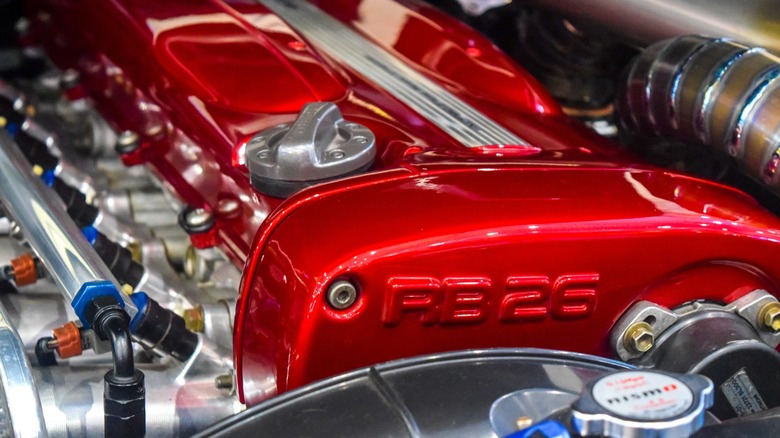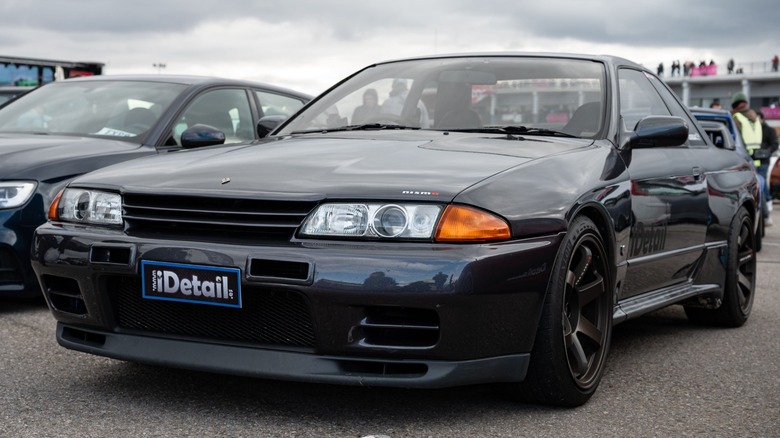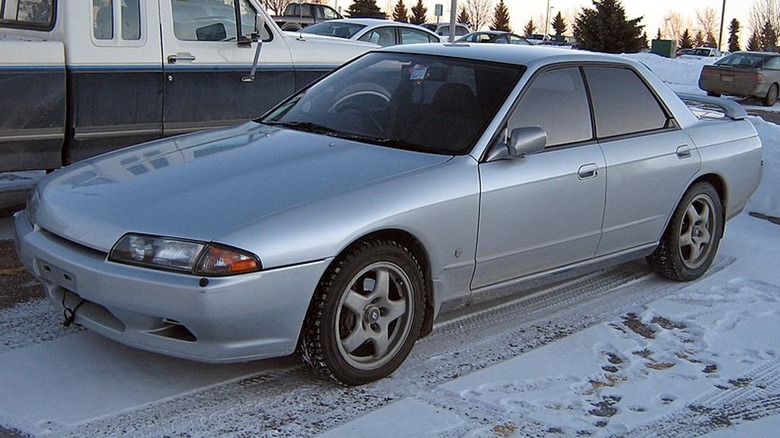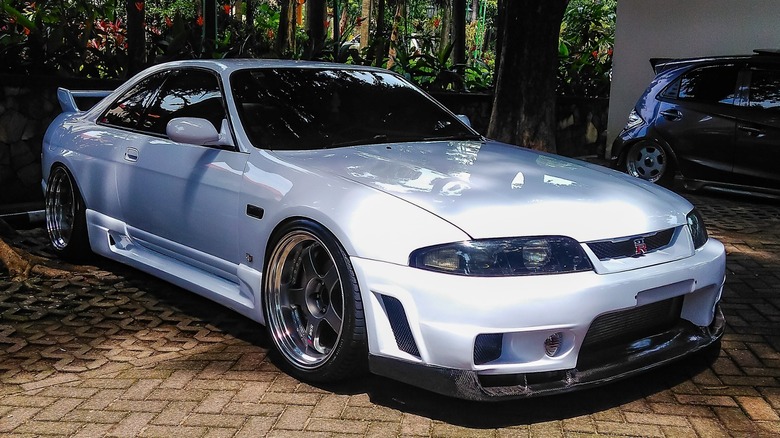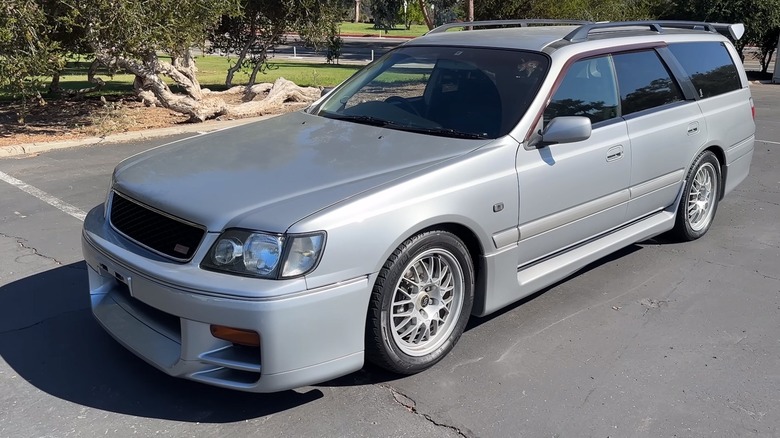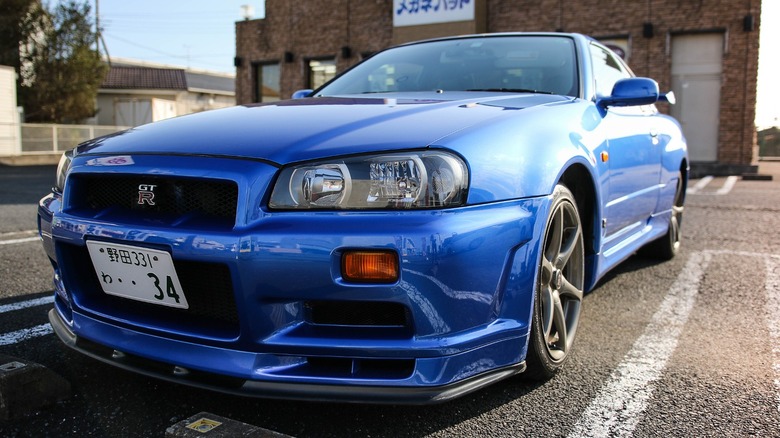Which Cars Came Equipped With Nissan's RB26 Engines & What Makes It So Powerful?
The most popular variant of the Nissan RB series engine is the RB26DETT, which is so-called because it has a 2.6 liter displacement, uses a dual-overhead cam with electronic fuel injection and comes with twin turbos from the factory.
The RB26DETT achieved legendary status because of its use in the three generations of the iconic Nissan Skyline GT-R Godzilla sports cars. Unfortunately, these Skylines are some of the coolest cars you can't buy in America, so you'll rarely catch a glimpse in person. Nevertheless, the enduring popularity in Hollywood — specifically in "The Fast & The Furious" franchise — made the Skyline GT-R a popular dream car for many kids.
Aside from that, the RB26 has a well-deserved reputation for bringing a lot of power to the table. Its cast iron block gave all RB engines enough strength to withstand high boost pressures, while the RB26DETT variant used individual throttle bodies for each cylinder. The RB engine's reliability, plus its ease of tuning, made the RB26DETT the darling of the tuner world. So, if you want to get your hands on a car that sported this motor, check out these models with an RB26 engine.
1989 R32 Nissan Skyline GT-R
Although the 1989 R32 Nissan Skyline GT-R wasn't the first Nissan GT-R, it was the first one to sport the RB26DETT engine and get the Godzilla moniker. The R32 GT-R had an all-wheel drive drivetrain, giving it excellent grip and maneuverability on the track. With this combination, the R32 took the top spot in Bathurst 1,000 — one of the toughest endurance races you could enter in 1990.
Aside from its real-world racing chops, the R32 GT-R also made a name for itself as one of the cars you can get in the original Gran Turismo game on PlayStation. So, both car racing enthusiasts and gamers alike became enamored with the prowess of this vehicle.
Nissan produced the R32 GT-R from 1989 until 1994, with over 40,000 units rolling off its factory floor. Officially, the R32 only hit 276 hp, reportedly because of an historic gentleman's agreement between the Japanese government and its major automakers. In reality, however, a stock R32 GT-R had a capacity of at least 320 hp, and if you tuned and upgraded the engine, some enthusiasts have pushed up to 1,000 hp and beyond.
1992 Nissan Skyline 26 Autech
The most popular variant of the RB26 engine is the RB26DETT. However, Nissan also made a naturally aspirated version of the engine, the RB26DE, to power the Nissan Skyline 26 Autech sedan. This four-door car featured the same engine as the more powerful R32 Skyline GT-R but without the twin turbos, thus making it a bit more sedate, fittingly, as it's an entry-level luxury or compact executive car.
The Skyline 26 Autech still features the same all-wheel drive system found on its sportier brother, so you can still have fun with the car on the track. As the RB26DE engine loses out on forced induction, the car's output drops to 217 hp from the official 276 hp figure. Nevertheless, it's still enough to drive the car from zero to 60 in under eight seconds.
Unfortunately for those who want to get their hands on the Skyline 26 Autech, this model was a limited edition run, and Nissan only made 200 units. So, this is not the vehicle you're looking for if you want a budget R32 Nissan Skyline GT-R — it's going to be far more expensive than the Godzilla due to its rarity.
[ Featured image by dave_7 via Wikimedia Commons | Scaled and cropped | CC BY 2.0 ]
1995 R33 Nissan Skyline GT-R
The R33 Nissan Skyline GT-R is the second of three Skyline GT-R models to get the legendary RB26DETT. It's also often the most overlooked because of its bigger dimensions than its younger and older siblings. However, you shouldn't disregard this car, as it was the first production car to break the eight-minute lap in the Green Hell race at Nürburgring.
The 1995 R33 GT-R, again like its older equivalent, officially had 276 hp. However, since it had the same engine as the R32, you can expect its actual output to also be closer to 320 hp. As the R33 is slightly heavier than the R32, it had a slower zero to 60 time of 5.3 seconds, compared to the R32's 5.1 seconds. Nevertheless, the R33 had a stiffer body, improved weight distribution, and better traction control. This meant that even if the R32 would beat its younger brother in a straight line, the R33 would be faster around the track because of its improved responsiveness and drivability.
The R33 also had something that no other Nissan GT-R model had: a four-door sedan version. Nissan released the 1998 Nissan Skyline GT-R Autech 40th Anniversary Edition to celebrate the longevity of the Skyline nameplate, but only made 416 examples of this sedan. Curiously, the R33 coupe can still sell for a high price today, with a good condition example fetching around $75,000. On the other hand, the rarer four-door R33 version usually gets less, at around $60,000. Therefore, if you want to buy an affordable GT-R with a twin-turbo, find an example of the 40th anniversary sedan.
1996 Nissan Stagea 260RS
The Nissan Stagea is the station wagon version of the base model on which the legendary Nissan Skyline GT-R is built. Given that, Nissan's in-house tuning company, Autech, decided to install the RB26DETT engine in the Stagea, thus giving birth to the Nissan Stagea 260RS. The 1997 to 2001 model years of the Stagea featured the RB26DETT engine option. Furthermore, that line offered all-wheel drive technology and a five-speed manual transmission — almost everything you want from the GT-R.
Nissan made 1,734 units of the Stagea 260RS, so it's unlikely you'll see one out on the road. Nevertheless, the Stagea 260RS makes for one great sleeper car, as nobody would expect a station wagon, especially one that's not an Audi RS6, to be so quick and nimble. Although newer, more modern cars have supplanted vehicles from the 1990s, the Stagea 260RS would most likely have made our list of the fastest station wagons ever built if it were updated and sold today.
1999 R34 Nissan Skyline GT-R
Of course, we cannot forget the most popular version of the Skyline GT-R — the R34. This is the car that Paul Walker drove in "The Fast & The Furious" series, thus keeping the GT-R flame alive for newer generations. The biggest difference of the R34 over its older siblings is that it has a shorter wheelbase and better aerodynamics. Aside from that and its looks, the R34 is mostly unchanged from the R33 and the R32 versions.
With its smaller size, the R34 regained the few seconds that the R33 lost in its zero to 60 run, bringing its time back to 5.1 seconds. As usual, the car had 276 hp on paper, although this would be the last model to have that number, as Japan would ditch the gentleman's agreement in late 2004 — two years after the R34 was discontinued.
The R34 GT-R ceased production in 2002, and it wasn't until 2007 that Nissan introduced a successor — the R35 Nissan GT-R, which, for the first time, is now available in the US. However, the R35 isn't powered by an inline-6 RB26DETT. Instead, it uses a V6 VR38DETT engine, initially a controversial topic among purists. Nevertheless, this engine has also stood the test of time, like the RB26DETT's 13-year run. As of the time of writing, the VR38DETT has been used on the GT-R from its inception in 2007 until today — a lifespan of over 17 years and counting.
